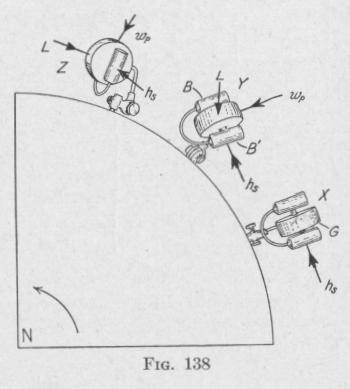176 NAVIGATIONAL COMPASSES
pendulous gyroscope from the horizontal develops a torque that produces a precession of the spin-axle toward the meridian plane. If the spin-axle be displaced out of the meridian plane, the northseeking end will oscillate back and forth around an elliptical orbit abcda, Fig. 137. This figure represents the path of the prolongation of the gyro-axle on a vertical plane as seen by an observer looking from the south toward the north. If the motion be undamped, the angular amplitude of each oscillation will equal the original angular displacement from the meridian. The period of vibration depends upon the torque acting on the oscillating system, the angular speed of the spinning gyro-wheel and upon the
moment of inertia of the oscillating system. It is always made to be about 84 minutes (Art. 113).
107. The Meridian-Seeking Tendency of a LiquidControlled Non-Pendulous Gyroscope. - Attached to the sides of the frame supporting the gyro-wheel, G, Fig. 138, are reservoirs joined by a small tube.* This figure represents the view as seen by an observer above the north pole of the earth. With the gyro-axle horizontal, the two
reservoirs are filled with mercury, up to the level of the middle
of the gyro-axle. The center of gravity of the gyroscope is raised
to the center of gravity of the gyro-wheel by means of an adjust
able counterpoise above each reservoir. This mercury-filled sys
tem is called a " mercury ballistic."
Suppose that at a particular instant the spin-axle is horizontal
and east and west as shown at X, Fig. 138. In Fig. 137, a line
along the spin-axle intersects the vertical plane XZ at the point a,
east of north. While the gyroscope is carried by the rotation of
the earth to the position Y, Fig. 138, the spin-axle tends to pre
serve its direction in space, thereby causing the reservoir B to be
raised above B' relative to the horizontal plane at B. Conse
quently, some mercury flows from the reservoir B to the reservoir
Ranrlirn, Nn 13(;2040 1920
THE VARIOUS TYPES 177
B', thereby producing a torque about a horizontal axis perpendicular to the plane of the figure and directed away from the reader. This torque produces a precession that causes the spin-axle to tend to set itself parallel to the torque-axis and with the direction of spin in the direction of the torque. As this torque continues, the spin-axle becomes parallel to the meridian plane, the tilt of the spin-axle becomes maximum and the direction of spin is opposite the direction of rotation of the earth. A line along the spin-axle now intersects the vertical plane at b, Fig. 137. The spin-axle crosses the meridian plane and becomes less tilted from the horizontal. The spin-axle becomes horizontal when the inclination to the meridian plane is maximum. A line along the spin-axle now intersects the vertical plane at c. Owing to the rotation of the earth, the dip will continue past the horizontal and mercury will flow toward the reservoir at B, thereby causing a precession in the reverse direction. During this precession, a line along the spin-axle traces a curve cda on the vertical plane.
The cycle of motions causes the end B' to trace an elliptical path with major axis horizontal, east and west, and minor axis vertical. The end B is the north-seeking end of the gyro-axle. If there be no damping, this motion is repeated with undiminishing amplitude. The period is made to be about 84 minutes (Art. 113). From the preceding consideration it is seen that the direction of spin of the liquid-controlled gyroscope is opposite to the direction of rotation of the earth, whereas the direction of spin of the pendulous gyroscope is the same as the direction of rotation of the earth.
108. Making a Gyroscope into a Gyro-Compass. - In Arts. 106 and 107 it has been shown that, owing to the rotation of the earth, the spin-axle of a gyroscope, with rotational freedom about a horizontal axis partially suppressed, will trace the surface of an elliptical cone. The apex of the cone is at the center of mass of the gyro. The axis of the cone is horizontal and in the meridian plane. The maximum amplitude of deviation of the spin-axle from the meridian may be many degrees. If the gyroscope were on the earth or on a stationary ship, the meridian could be located by taking the mean of the extreme positions of the spin-axle. The length of time required for this determination is so great that the gyroscope, as described, is quite useless for determining the course of a ship at sea.
To make a gyroscope into a gyro-compass, means must be pro
vided to damn the nseilla,tinns to sneh nn evtpntf that VPr,r n,,;o)rhr
